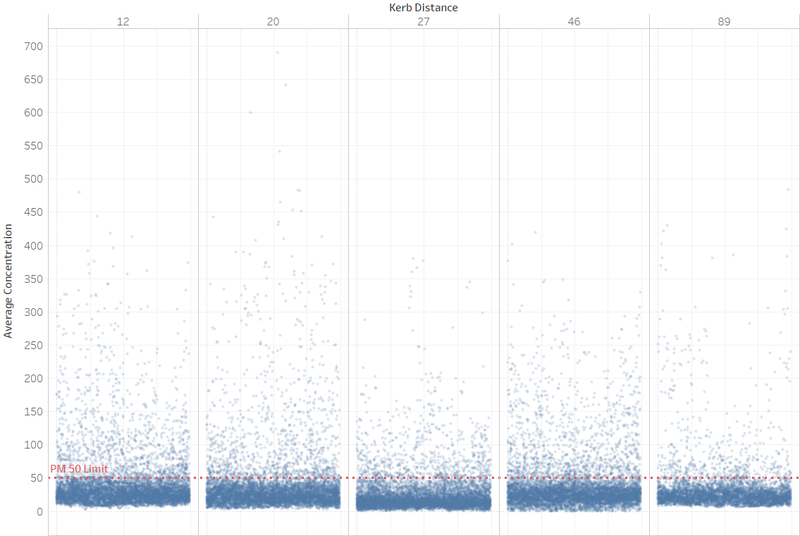ISSS608 2018-19 T1 Assign HyderAli Task 1 Insights
|
|
|
|
|
Two datasets were utilized for the study of official air quality in Sofia, the capital of Bulgaria. The first dataset is historical daily/hourly PM10 data (2013-2018) of Sofia obtained from the 6 Official Air Quality Stations. Observation values include PM10 cocentration, with parameter concentration units in micrograms per cubic metre (μg/m3). The second dataset was retrieved from the 6 air quality monitoring stations in Sofia, all with geographic coordinates. The observation data include time, temperature, humidity, wind speed, pressure, rainfall and humidity. We then proceed to consolidate the air quality data from the following sets:
- Official Air Quality Measurements - 6 Air Quality Stations
- Meteorological Measurements: Temperature, Humidity, Wind Speed, Pressure, Rainfall and Visibility from 6 Air Quality Stations
The consolidated data consists of 39,715 measurements from the 6 stations: BG0040A - 8393, BG0050A - 8378, BG0052A - 8280, BG0073A - 7743, BG0079A - 6004 and BG0054A - 917.
Characterize the past and most recent situation with respect to air quality measures in Sofia City. What does a typical day look like for Sofia city? Do you see any trends of possible interest in this investigation? What anomalies do you find in the official air quality dataset? How do these affect your analysis of potential problems to the environment? Your submission for this questions should contain no more than 10 images and 1000 words.
Contents
- 1 From 2013 to 2018...Typical Day on 14-Sep-2018
- 2 Has the Trend changed over the years?
- 3 Does Sofia's Air Quality Get Worse in Autumn/Winter?
- 4 Does Sofia's Air Quality time-invariant during Winter/Autumn periods?
- 5 Has the Trend changed over the years?
- 6 Day-of-Week Patterns of PM10 Levels
- 7 Locations of Particulate Matter Monitoring Sites
From 2013 to 2018...Typical Day on 14-Sep-2018
Daily time-series line plot between 2013 and 2018 contains mean daily concentration measurements across the 6 air quality monitoring stations, with no data between Jan-17 and Oct-17. The daily mean PM10 concentrations are highly fluctuating with an overall concentration of 42.1μg/m3, below the limit value of 50μg/m3. The highest peak was recorded on 22-Dec-2013 with a mean concentration of 354.4 μg/m3 along with other significant peaks during the Nov/Dec periods of the year. Through the basic visualization, we observe an overall decreasing trend in the daily PM10 concentrations over the 5 years between 2013 and 2018. Could the decreasing trend be representative of efforts by the citizens/environmentalist groups/government of Sofia City in meeting their long-term objectives of attaining a cleaner air?
Next, we proceed to focus on hourly mean concentration measurements on of the least polluted days: 14-Sep-2018. The hourly mean PM10 concentrations averages to approximately to 21.27μg/m3, below the limit value of 50μg/m3. The highest peak was recorded around 7am with a concentration of approximately 29.00μg/m3 and the lowest trough around 3pm of approximately 15.80μg/m3; the trend rises above the average line in the morning between 4am to 9am and then starts falling below the average line during the later portions of the day between 10am to 5pm.


Has the Trend changed over the years?
Trend of PM10 pollutant levels were positive in years 2013 and 2015. Likewise the trend was decreasing in 2014 with an overall stagnant growth in 2016. Overall, the trend was slightly decreasing between 2013 to 2018. The overall decreasing trend could be attributed to outreach programs and voluntary actions by individuals/organizations which aim to educate about health effects and sources of air pollution so as to reduce the overall pollution levels.
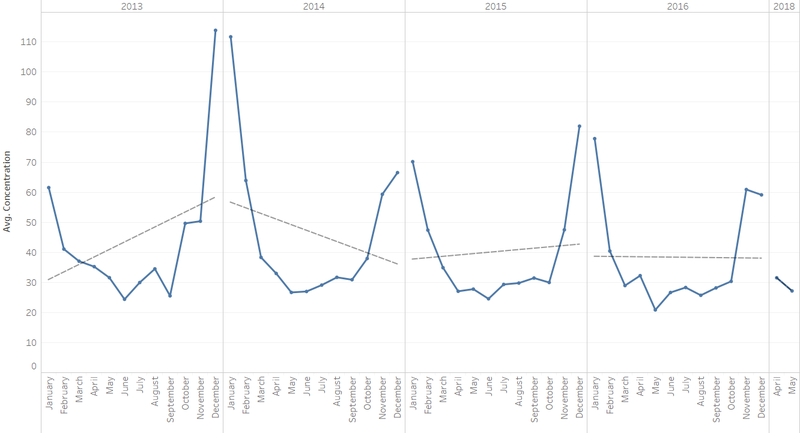
Does Sofia's Air Quality Get Worse in Autumn/Winter?
As shown in the calendar view, days with a mean PM10 concentration greater than 200 (heavily polluted) were concentrated from November to December and January to February. No significant difference was observed in PM10 concentration levels between weekdays and weekends. The temporal characteristic shows that the average PM10 concentration in Bulgaria was greater than the 50-limit over the five-year study period; therefore the residents suffer from long-term moderate pollution. The concentrations were more serious during the autumn/winter seasons: from November to February. A possible cause of such high pollution levels during the winter period could be due to a temperature inversion effect. Low temperatures and stagnant air during cold seasons have a way of creating a build-up of particulate matter near the ground whereby cold air is trapped near the ground by a layer of warm air which then acts like a lid to hold these substances down. Furthermore, the cyclic plot reveals that mean PM10 concentration levels were highest and above the 50-limit during November, December and January periods; 74.13, 70.32 and 50.64 μg/m3 respectively. Thus, people of Sofia city are advised to stay indoors during those time periods.
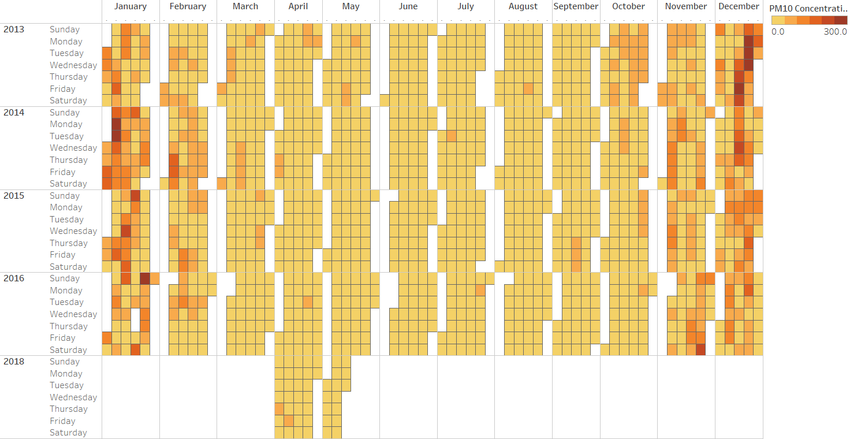
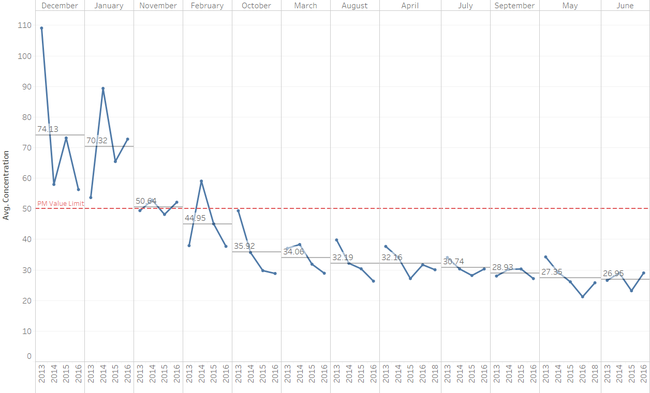
Does Sofia's Air Quality time-invariant during Winter/Autumn periods?
In the heatmap matrix below, column shows the monthly variation whilst the row shows the hourly variation in 24-h periods averaged across all years. In coherent to the calendar view map, days with a mean PM10 concentration greater than 50-limit occurs in periods between November to January. Basing on the heatmap matrix, PM10 concentration of more than 150 were concentrated from 8:00 a.m to 10:00 a.m. across the years, and the concentrations are most serious during November periods.

Has the Trend changed over the years?
Trend of PM10 pollutant levels were positive in years 2013 and 2015. Likewise the trend was decreasing in 2014 with an overall stagnant growth in 2016. Overall, the trend was slightly decreasing between 2013 to 2018. The overall decreasing trend could be attributed to outreach programs and voluntary actions by individuals/organizations which aim to educate about health effects and sources of air pollution so as to reduce the overall pollution levels.

Day-of-Week Patterns of PM10 Levels
It is quite useful to analyze variations by day of week in the PM10 concentration data. The highest recorded PM10 concentration occurred on Thursday (42.08 μg/m3) whilst the lowest recorded PM10 concentration occurred on Saturday (38.31 μg/m3). The PM10 concentrations exhibited a general weekly pattern, with the maximum occurring late in the workweek and the minimum occurring on weekends (especially Saturday); this pattern prevails at all Air Quality Station sites. Some researchers have postulated that the higher pollution levels on weekdays could be attributed by higher traffic of heavy-duty vehicles, which represent a major source of elemental carbon.

Locations of Particulate Matter Monitoring Sites
As the levels of PM10 were measured in 6 different stations at the city of Sofia, we proceed to evaluate the association between the particulate matter levels and the spatial locations. The measurements showed that the PM10 concentrations in the stations were between 24.6 and 51.2 μg/m3. All measurements were recorded near the center of Sofia City based on the spatial locations of the 6 stations. The highest recorded average PM10 concentration of 51.2 μg/m3 belonged to STA-BG0054A, which recorded only 917 (2.3%) out of 39,715 measurements. Measurement Records from STA-BG0040A (21.1%), STA-BG0050A (21.1%), STA-BG0052A (20.8%) and STA-BG0073A (19.5%) were well distributed and recorded an average PM10 concentration level below the PM-50 limit. It was also worthwhile to observe that the measurements from STA-BG0079A (15.1%) recorded measurements only during the weeks 14, 18 and 19 over the years with an average of 24.6 μg/m3. Thus, the pollutant level measurements do depend on how rural/urban the sampling site is. The air-quality measures generally suggest that air quality improves as areas become more rural (or less urban) due to decreased human activity and lesser peak vehicle traffic.
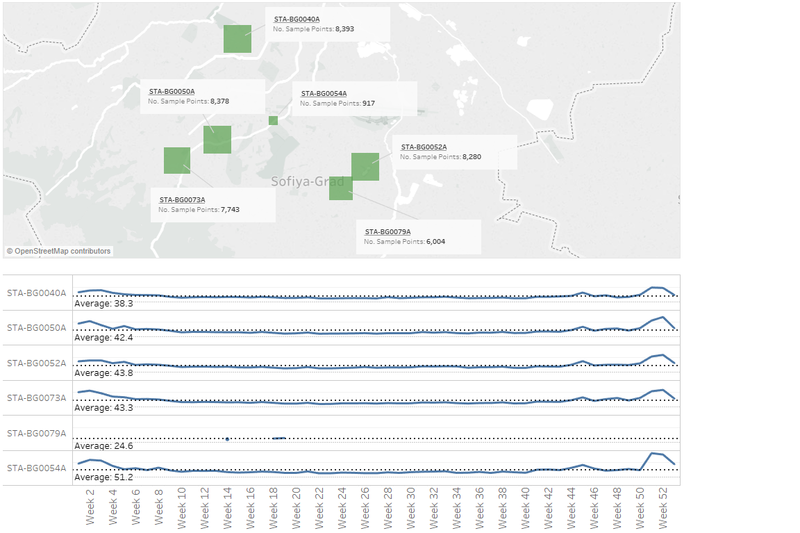
Firstly, kerb distance refers to the distance in metres, from the edge of a busy road. Classifying the PM10 average concentration levels by the kerb distance, we could clearly see that monitoring sites closer to road traffic recorded higher measurement of the pollutant levels.
